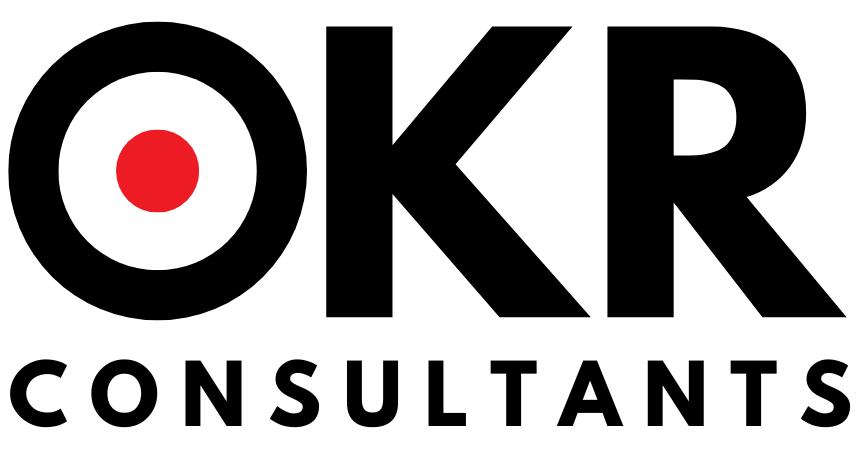Example OKR Worksop Agenda
Designing an Effective OKR Workshop Agenda for Companies
Objectives and Key Results (OKRs) are a proven framework to align strategy, increase focus, and measure outcomes. But successful adoption doesn’t happen by sending a slide deck. Teams need context, practice, and time to connect OKRs to real work. A well-structured workshop agenda provides exactly that: shared understanding, hands-on drafting, and clear next steps.
Example OKR Workshop Agenda
- Workshop Begins: 9:00am
- OKR Training I
- Morning Break: 10:15 – 10:30am
- OKR Training II
- Lunch: 12:30 – 1:00pm (Lunch served in the restaurant)
- Workshop I
- Afternoon Break: 3:15 – 3:30pm
- Workshop II
- Reflection & Next Steps: 5:00pm
- Finish: 5:30pm
9:00am – Welcome and Introduction
Set the tone for focus and transparency. Confirm objectives, agenda, and expected outcomes. A quick round of introductions helps participants anchor examples in their day-to-day roles and build a collaborative atmosphere from the start.
OKR Training I: Understanding the Basics
Lay the foundation: what OKRs are, how they differ from KPIs, and why they work. Cover the OKR structure—qualitative Objective and quantitative Key Results—and the role of ambition and stretch. Discuss common pitfalls, such as writing tasks instead of results. Use brief exercises to rate sample OKRs so participants experience the difference between weak and strong formulations.
- Purpose and principles of OKRs
- Objective vs. Key Results: clarity and measurability
- Stretch goals and focus
- Typical mistakes to avoid
10:15 – Morning Break
A short pause for reflection. Informal conversations here often surface first insights about how OKRs could fit the organization’s workflow and culture.
OKR Training II: From Theory to Application
Bridge the gap to practice. Show how to derive OKRs from strategy and how top-down and bottom-up alignment works. Emphasize writing outcome-driven Key Results and designing a quarterly cadence with regular check-ins. Include a quick critique exercise where teams improve poorly written examples.
- Linking OKRs to company strategy
- Top-down intent and bottom-up ownership
- Outcome-focused, measurable Key Results
- Quarterly cycles, check-ins, and reviews
12:30 – Lunch Break
Use the informal setting to exchange perspectives and challenges. Participants often refine their focus areas over lunch, making the afternoon work more productive.
Workshop I: Drafting OKRs
Move from theory to creation. In small groups (by function or project), participants draft first OKRs for the upcoming cycle. The facilitator provides templates and guardrails, but the emphasis is on doing the work together.
- Brainstorm Objectives tied to strategic priorities
- Separate outputs (tasks) from outcomes (results)
- Draft first versions of OKRs
- Peer feedback across groups
This session transforms learning into tangible drafts and builds confidence in the process.
3:15 – Afternoon Break
A brief reset before alignment work. Many teams use this time to tighten wording and sharpen measurability in their Key Results.
Workshop II: Alignment and Prioritization
Ensure coherence across teams. Groups present their drafts, identify overlaps or dependencies, and agree on the few Objectives that matter most. Discuss how progress will be tracked (dashboards, owners, and check-in rhythm) and how cross-team work will be coordinated.
- Share and stress-test draft OKRs
- Resolve conflicts and dependencies
- Prioritize Objectives for the quarter
- Define owners, metrics, and check-in cadence
5:00 – Reflection & Next Steps
Consolidate learning and commitments. Capture key takeaways, clarify open questions, and agree on the implementation plan. Provide templates and a lightweight governance model so teams can maintain momentum after the workshop.
- Weekly/bi-weekly check-ins and hygiene
- Mid-quarter review for re-focus
- End-of-quarter retro and learning loop
- Tooling options (spreadsheets or OKR platforms)
5:30 – Finish
Close with a concise summary and next steps. Consider a short networking moment to celebrate progress and strengthen cross-team relationships before execution begins.
Why a Structured Agenda Matters
A clear agenda balances learning and doing. Participants leave with shared language, practical skills, and draft OKRs they own. The flow from fundamentals to application, and from drafting to alignment, reduces confusion and accelerates adoption. Companies that follow this structure typically see faster OKR rollout, better focus, and higher engagement.
Conclusion
OKRs can transform how organizations set and achieve goals—if they are introduced with care and practice. A well-designed workshop agenda equips teams to write outcome-focused OKRs, align across functions, and establish a sustainable operating rhythm. Invest in the workshop, and you invest in a culture of clarity, accountability, and continuous learning.
